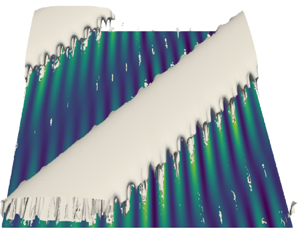Article contents
Turbulent transition in a channel with superhydrophobic walls: anisotropic slip and shear misalignment effects
Published online by Cambridge University Press: 08 February 2024
Abstract

Superhydrophobic surfaces dramatically reduce skin friction of overlying liquid flows. These surfaces are complex and numerical simulations usually rely on models to reduce this complexity. One of the simplest consists of finding an equivalent boundary condition through a homogenisation procedure, which in the case of channel flow over oriented riblets, leads to the presence of a small spanwise component in the homogenised base flow velocity. This work aims at investigating the influence of such a three-dimensionality of the base flow on stability and transition in a channel with walls covered by oriented riblets. Linear stability for this base flow is investigated: a new instability region, linked to cross-flow effects, is observed. Tollmien–Schlichting waves are also retrieved but the most unstable are three-dimensional. Transient growth is also affected as oblique streaks with non-zero streamwise wavenumber become the most amplified perturbations. When transition is induced by Tollmien–Schlichting waves, after an initial exponential growth regime, streaky structures with large spanwise wavenumber rapidly arise. Modal mechanisms appear to play a leading role in the development of these structures and a secondary stability analysis is performed to retrieve successfully some of their characteristics. The second scenario, initiated with cross-flow vortices, displays a strong influence of nonlinearities. The flow develops into large quasi-spanwise-invariant structures before breaking down to turbulence. Secondary stability on the saturated cross-flow vortices sheds light on this stage of transition. In both cases, cross-flow effects dominate the flow dynamics, suggesting the need to consider the anisotropicity of the wall condition when modelling superhydrophobic surfaces.
- Type
- JFM Papers
- Information
- Copyright
- © The Author(s), 2024. Published by Cambridge University Press
References
- 1
- Cited by





